Low-maintenance and budget-friendly, gravel patios offer incredible versatility without compromising on style. Their natural texture, excellent drainage, and easy installation make them a smart option for homeowners looking to upgrade outdoor living areas with minimal fuss. Whether paired with sleek modern furniture, cozy fire pits, or lush greenery, gravel sets the stage for a wide range of design aesthetics. From French-inspired layouts to casual garden retreats, this material adapts to various styles while remaining highly functional. This guide explores the best gravel patio ideas to help you design a space that looks great, feels welcoming, and stands up to everyday use.
Grid‑framed gravel squares
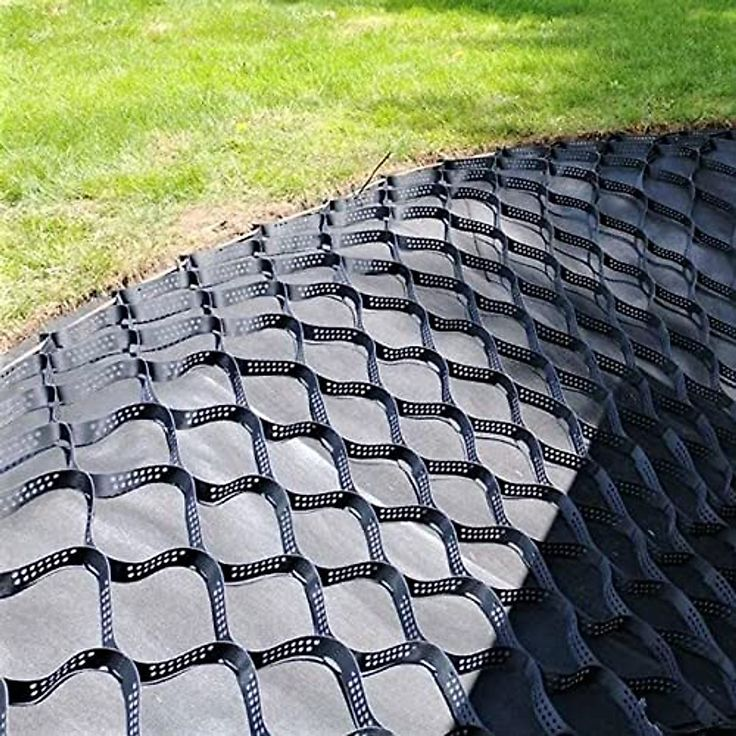
Framed symmetry adds a refined edge to gravel patios when arranged in grid-style squares. Framing each gravel unit with wood, metal, or stone borders helps define space while introducing structured rhythm to the layout. This method is especially practical for large yards where organization brings visual calm. The gravel squares can alternate in tone or fill to subtly vary texture across the patio surface. Small ornamental trees or sculptural planters in select squares can break up monotony while enhancing aesthetic flow. For functionality, the framed format also keeps gravel neatly contained, reducing displacement from heavy foot traffic. This makes it easier to maintain clean edges between greenery, gravel, and built features. Opting for high-contrast gravel colors or planting succulents in grid gaps creates more dimension without overwhelming the composition. The grid concept works well for both modern minimalist and rustic outdoor themes, depending on the materials used for edging. In rainy regions, permeable gravel allows water drainage while the frames help with soil retention underneath. These framed units are also DIY-friendly, offering flexibility to homeowners looking to define sections for seating, fire pits, or small dining setups. The grid-framed style balances order with raw texture, making it a versatile design for refined outdoor lounging.
Sunken gravel lounge area
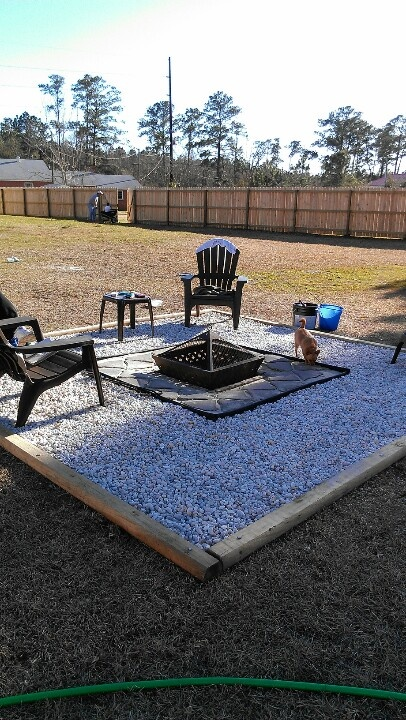
Recessed patio zones introduce a sense of retreat, and gravel is the perfect material to finish a sunken lounge with a relaxed yet polished touch. Excavating just a few inches below ground level, then lining the area with edging stones or timber, builds a quiet alcove ideal for fireside chats or intimate gatherings. The gravel’s natural drainage properties prevent puddling, making it a smart option for low-lying sections. Layering in deep seating or built-in benches can frame the lounge’s center, while lanterns, candles, or even sunken fire bowls create a warm nighttime ambiance. To visually separate the sunken zone from the rest of the yard, border it with ornamental grasses, low shrubs, or stepping stones leading in. Choosing gravel in a soft neutral tone ensures the space feels grounded without being stark. For added comfort, consider rubber or mesh pads beneath chairs to stabilize them on the gravel. This type of lounge is especially effective in backyards with sloped terrain where natural topography aids in defining the recessed shape. When paired with soft outdoor textiles and layered lighting, a gravel sunken lounge delivers serenity and style with low-maintenance appeal. It’s a seamless integration of natural elements and inviting design.
Pea‑gravel dining pad
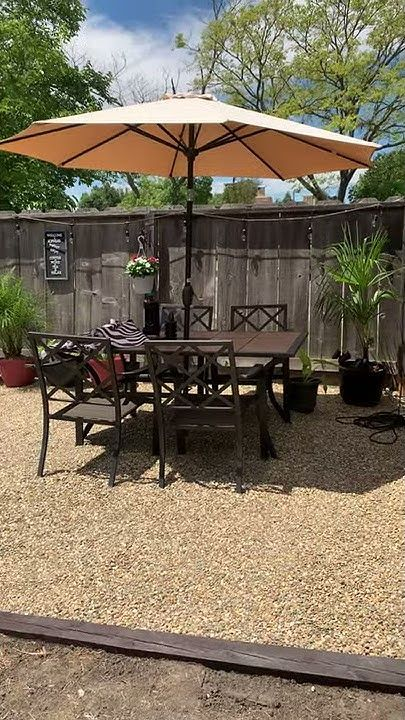
Dining al fresco gains charming simplicity when the table rests on a pea-gravel pad. The fine texture of pea gravel offers both aesthetic appeal and practical comfort underfoot. A dedicated gravel dining area distinguishes itself from the surrounding yard while providing stability for tables and chairs. Installing a defined border with steel edging or brick pavers keeps the gravel neatly contained and visually framed. Because pea gravel is softer than coarser options, chairs settle more evenly without wobbling—ideal for meals and gatherings. The gentle crunch of footsteps adds an auditory cue that enhances the outdoor dining experience. Situate the pad near a shade tree, garden bed, or pergola for natural ambiance. Accent lighting, such as string lights or lanterns, amplifies the mood during evening meals. For design consistency, match the gravel tone with nearby hardscaping or furniture materials. This gravel format adapts well to both modern and rustic themes, blending texture and comfort. The pad’s size can easily scale up for larger gatherings or remain compact for cozy meals. Whether part of a larger patio layout or a standalone feature, a pea-gravel dining pad creates a purposeful space that’s inviting, easy to maintain, and naturally integrated into the backyard.
Flagstone slabs in gravel base
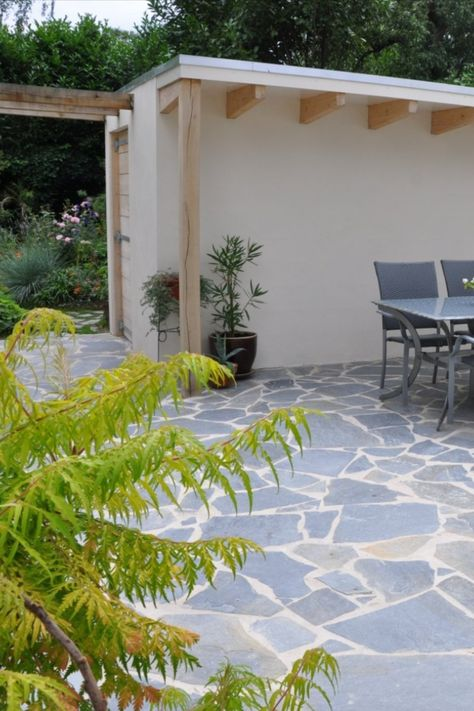
Wide flagstone slabs set into gravel create a harmonious balance of organic form and geometric foundation. This pairing provides both texture and function, allowing the gravel to fill joints and serve as a stabilizer while giving the layout visual fluidity. Unlike mortar-set stone, placing flagstones in a gravel base allows flexibility over time and promotes better drainage. The combination works particularly well in areas prone to rainfall or where weeds might be a concern, as the gravel helps suppress growth and keeps water moving. Arrange the stones irregularly or in gentle curves to emphasize a relaxed, natural look, or line them more symmetrically for structured appeal. The gravel color can be coordinated with the flagstone—think warm buff tones with golden gravel or grey slabs with slate-like fill—for a unified effect. In between the larger stones, low-growing ground cover or moss can soften transitions while enhancing texture. This approach is ideal for patios, garden paths, or poolside areas where you want durability without compromising on character. For extra comfort, focus the flagstone in high-traffic zones and let gravel define the peripheral space. The result is an attractive, resilient surface that anchors outdoor living with organic charm.
Wicker seating cottage-style patio

Cottage-style charm finds a natural ally in gravel patios adorned with classic wicker seating. The combination evokes an informal, inviting atmosphere that encourages slow mornings and long conversations. Wicker chairs or loveseats provide the tactile warmth and visual softness that contrast beautifully with the gravel’s rugged texture. Arranging seating in circular or conversational layouts enhances the relaxed energy, while vintage-inspired cushions or throws introduce cozy color and comfort. To ground the setup, a border of bricks, timber, or low stone edging helps define the patio without hard lines. Choose fine gravel in natural beige or soft gray to soften the space further and keep foot comfort a priority. Nearby flowerbeds brimming with blooms like lavender, roses, or daisies can reinforce the cottage aesthetic. Tucking in a small bistro table or garden cart adds practical function for tea or brunch. Overhead, a pergola draped in vines or hanging baskets heightens the cozy vibe. Solar lanterns or candle-lit jars scattered throughout offer evening illumination without overpowering the setting. This gravel-wicker pairing works especially well in gardens where nostalgia and greenery dominate. It’s a design that celebrates simplicity, warmth, and timeless appeal—all wrapped into an outdoor nook that feels like an extension of home.
Gravel pathways edged with pavers

Structured gravel paths bordered with pavers offer both direction and definition across garden landscapes. The contrast between soft gravel fill and solid paver edges provides clear boundaries while preserving a natural, informal walking surface. This technique is highly adaptable—straight pathways can channel movement efficiently through large yards, while winding paths invite leisurely strolls in intimate gardens. Gravel’s permeability helps manage runoff, making it an environmentally smart choice, while the paver edges prevent the stones from spilling into adjacent lawn or beds. Depending on the desired style, pavers can be rustic bricks, clean-cut concrete, or even reclaimed stone. For cohesion, echo paver colors in nearby patio elements or furniture. Lighting tucked into the borders or nestled into low planting beds can guide nighttime navigation without overwhelming the mood. To soften the edges, low-growing herbs or grasses spilling slightly over the pavers can add texture and scent. This path style blends utilitarian purpose with thoughtful design, ensuring that outdoor movement flows smoothly while still feeling organic. Whether leading to a focal point or weaving casually between garden rooms, gravel paths with paver edges bring elegance and intention to the garden’s connective spaces.
Zen gravel corner with moss & boulders
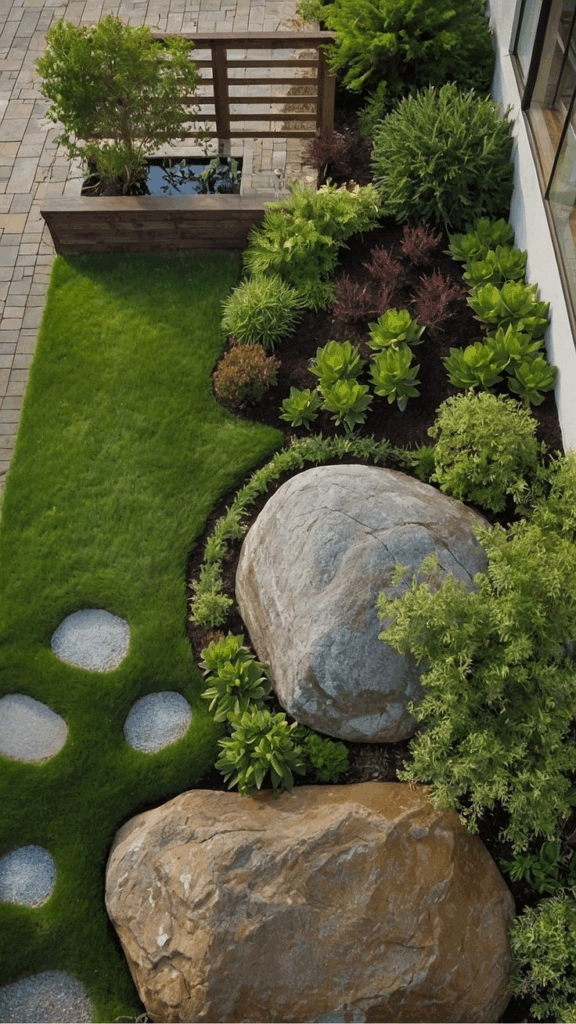
Quiet contemplation spaces thrive in corners where gravel meets moss, stone, and stillness. A Zen-inspired gravel patio draws from principles of balance, simplicity, and harmony with nature. Choosing fine gravel in soft white or gray helps reflect light and encourages a sense of spaciousness. Raked patterns can add rhythm and mindfulness to the surface, while moss creeping between boulders or low platforms introduces softness and grounding. These elements work together to foster an atmosphere of reflection and calm. Position a low bench, ceramic stool, or flat rock for meditative seating, and shield the area with a privacy hedge or bamboo screen for added seclusion. Include a shallow water feature or wind chimes for subtle ambient sound that doesn’t disrupt the tranquility. This gravel layout benefits from minimalism—limiting furnishings and distractions to emphasize connection with nature. A single sculptural element, such as a lantern or standing stone, can act as a focal point. The garden’s location should receive dappled light or partial shade to protect the moss and maintain the area’s cool, quiet feel. Ideal for urban backyards or unused side zones, this Zen gravel corner becomes a deeply personal space for restoration and quietude.
Grass‑jointed pavers in gravel
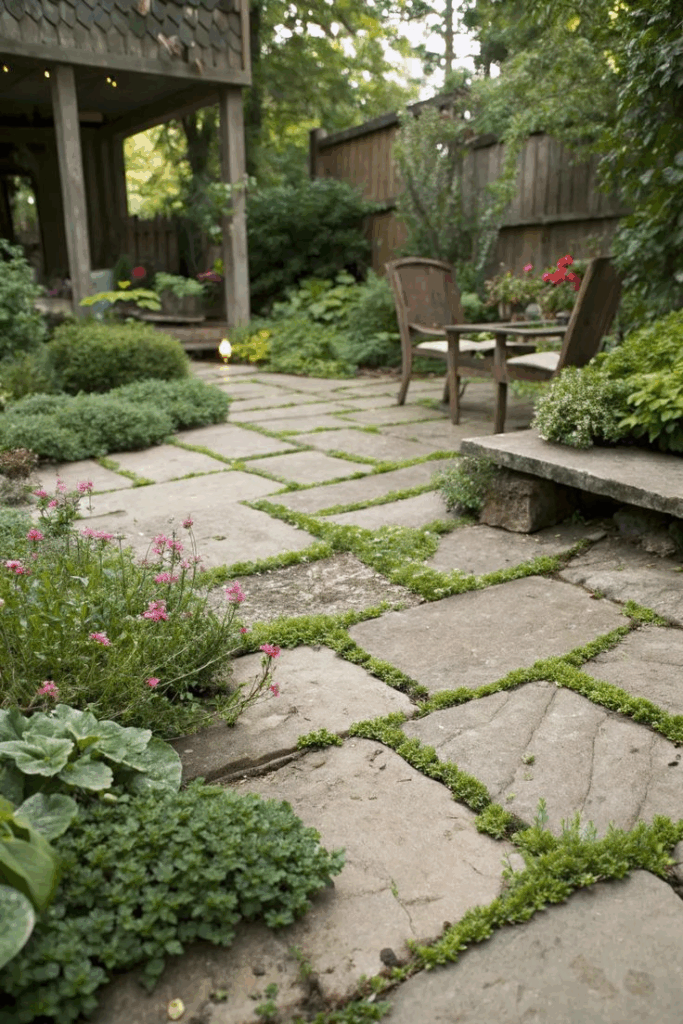
Checkerboard layouts made with alternating tiles and gravel offer a visually striking foundation for patios. The geometric interplay balances symmetry with texture, making it ideal for modern and transitional outdoor styles. Start by creating a grid using concrete, porcelain, or natural stone pavers, leaving consistent gaps between each to fill with compacted gravel. This format not only brings visual clarity but also offers better drainage than solid-slab surfaces. Choose gravel in a contrasting shade to the tile for more definition—such as dark pebbles with white pavers or tan stone against charcoal squares. This layout can span an entire patio or be used as a feature zone within a larger gravel area. To soften the linear precision, add curved furniture or organic plantings nearby. The checkerboard effect also works well under pergolas or in front-yard courtyard settings. For stability, ensure a level gravel base and secure edge restraints. This design is easy to maintain and allows for modular expansion or repairs. Whether framing a seating area or creating a playful transition between zones, the mix of materials in this pattern adds sophistication and rhythm to outdoor living without sacrificing permeability or practicality.
Large planters anchoring gravel zone
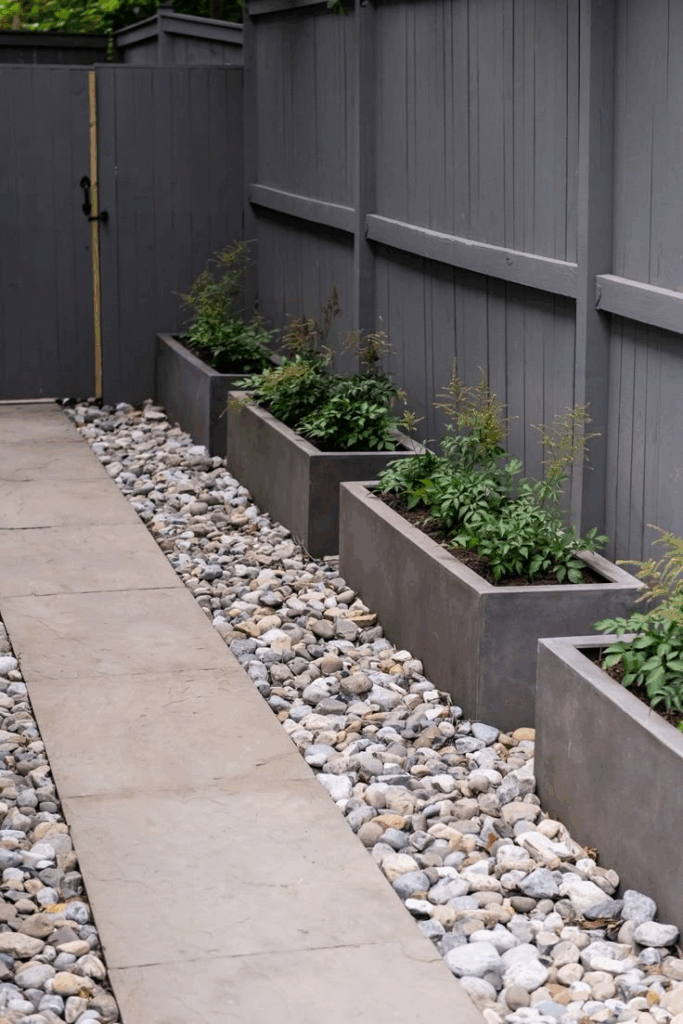
Combining multiple gravel types—such as river rock and pea gravel—within a single layout introduces dynamic contrast in color, size, and texture. This approach works especially well in larger spaces where visual variation prevents monotony. Use larger river rocks to define borders, fill swales, or create dry creek beds, while smoother pea gravel forms the primary patio surface. The mix not only elevates design but also helps with practical water management, as coarser stones facilitate runoff and finer gravel compacts for comfortable walking. Distinct transition lines between textures can be soft curves or crisp edges, depending on the desired look. Plantings like ornamental grasses or succulents can enhance the effect, echoing the layered natural textures underfoot. When executed well, this technique adds depth and movement to an otherwise flat space, especially when viewed from above or at a distance. It’s ideal for patios that blend into surrounding gardens or incorporate water features. Maintenance remains low, with clear divisions helping to localize wear or future adjustments. This textural fusion delivers a sophisticated, landscape-inspired ambiance, letting natural materials play off each other to create a layered, cohesive outdoor zone.
Checkerboard tile‑and‑gravel layout
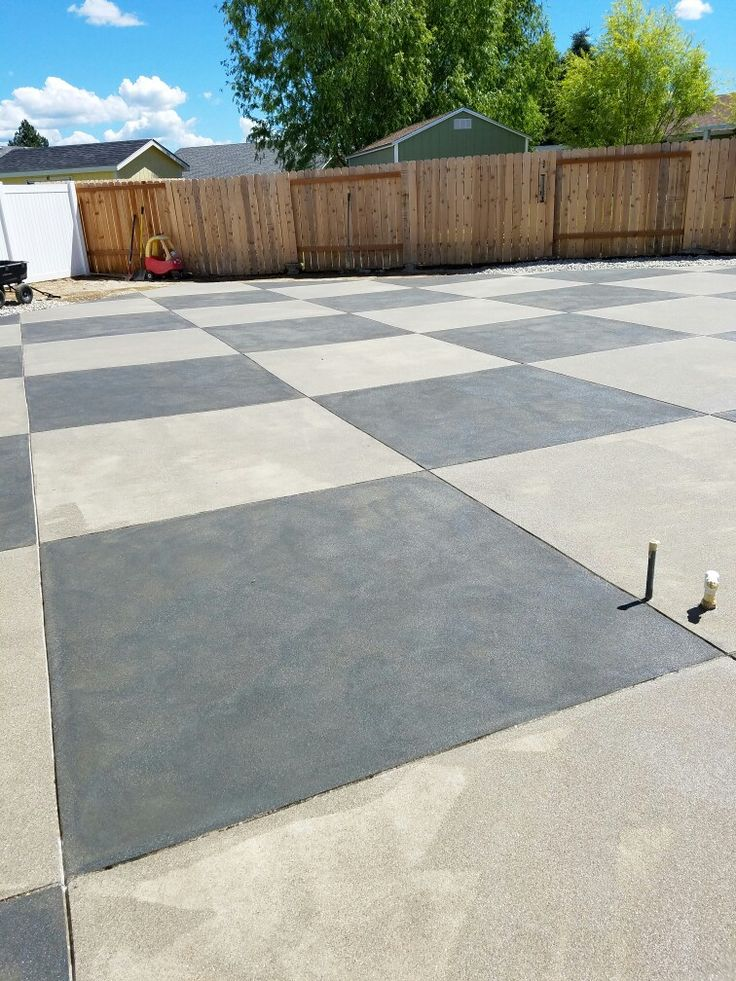
Timber borders add definition and character to gravel patios, especially when used to create raised edges. These timber-framed gravel beds elevate the entire aesthetic while helping to contain the stones and shape the layout. Pressure-treated lumber or hardwoods like cedar provide longevity and resistance to weather. The raised edges create clean transitions from lawn, deck, or garden beds, giving the patio a polished finish. Gravel can be filled flush with the timber or left slightly lower for a framed-in feel. Consider staining or sealing the wood to coordinate with surrounding furniture or trim elements. Raised gravel beds work particularly well on sloped yards where retaining edges are needed to stabilize the surface. Inside the timber frame, finer gravel ensures a stable base for furniture, while coarser stone can be layered below for drainage. Lighting can be embedded along the timber for nighttime use, and low plantings at the edges soften the lines. This setup allows flexibility in shape—rectangular, curved, or sectional—and makes it easier to clean and maintain the gravel surface. It’s a design that fuses form with function, offering both style and structural support for long-term outdoor enjoyment.
Mixed‑texture zones (river rock + pea gravel)

Blending soft-toned gravel with architectural concrete creates a sleek and understated patio that complements a wide range of home styles. Concrete accents—like pads, benches, or low retaining walls—serve as anchor points within a gravel field, adding permanence and contrast. Light gray or tan gravel serves as a neutral base that reflects sunlight and visually expands smaller outdoor spaces. Concrete’s solid surfaces offer stable footing in high-traffic zones, while the gravel between adds permeability and tactile appeal. Together, these materials strike a balance between industrial and natural aesthetics. Design-wise, concrete forms can be poured in geometric shapes or organic curves to align with the space’s overall tone. Low-profile concrete edging helps maintain gravel boundaries while offering clean lines. This mix also allows for strategic zoning—seating on gravel, grilling on concrete, for example—without the need for full paving. Accent the area with minimalist furniture or potted succulents for a clean finish. Whether for front courtyards or backyard retreats, this pairing creates a calm, grounded environment with practical resilience to foot traffic and seasonal changes.
Raised timber‑edged gravel beds
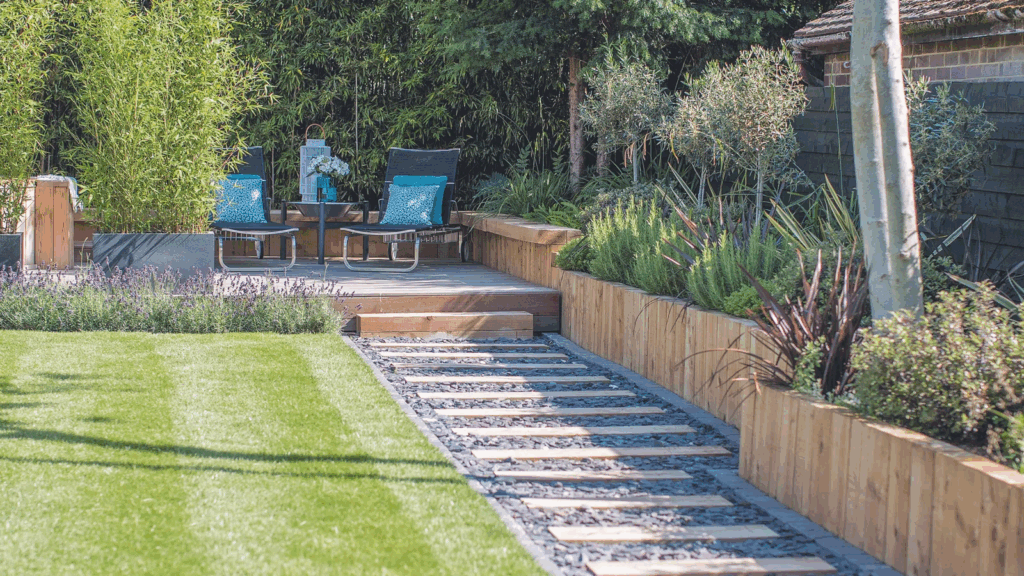
Flat, elongated gravel lanes modeled after bocce courts bring casual recreation and elegance to the backyard. These lanes double as functional entertainment features and stylish patio elements. Constructed with timber or stone borders, the rectangular strip is filled with crushed gravel that’s compact enough for gameplay yet textured enough to maintain its rustic charm. The layout often spans 8 to 13 feet wide and can reach 60 to 80 feet long, though scaled-down versions suit smaller yards just as well. Leveling the ground is crucial for gameplay and visual neatness, with a slight crown in the middle to aid drainage. Neutral gravel tones like gray or gold blend into landscape palettes while contrasting with green lawns or garden beds. Border plantings can soften the edges and visually integrate the court with its surroundings. Even when not in use, the long linear feature provides a design focal point and clear directional flow across the yard. Night lighting along the edges or built-in benches nearby can extend its function beyond the game. Ideal for family spaces or social yards, a bocce-style gravel lane combines leisure and landscape in a way that feels timeless and tailored.
Neutral‑tone gravel with concrete accents
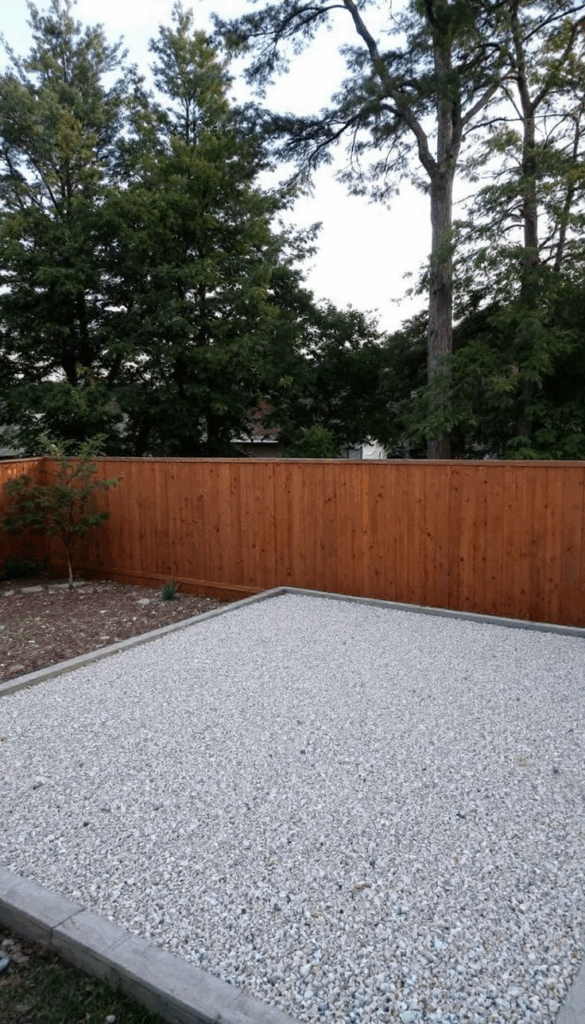
Gravel patios feel extra inviting when nestled beneath a pergola and lit with strands of soft fairy lights. This setup transforms a basic patio into a cozy retreat perfect for evenings and quiet weekends. The gravel base keeps the design grounded and breathable, while the overhead structure offers shade and a defined ceiling for ambiance. Hanging string lights across the pergola adds a warm glow that complements the gravel’s natural tones. Choose fine pea gravel or decomposed granite for comfort underfoot, and contain the area with timber edging or low stone borders. The pergola frame can be left natural or painted to match exterior decor. Climbing plants like jasmine or ivy can wind up the posts for added greenery and fragrance. Inside the space, furnish with weather-resistant lounge seating or a café-style dining set. Scatter lanterns or floor cushions to encourage lingering and conversation. Even during daylight hours, the pergola provides structure and visual interest, while at night, the lights turn it into a magical haven. This pairing of rugged ground and delicate lighting layers texture and atmosphere in a way that’s welcoming year-round.
Bocce‑court style gravel lane

Long, narrow gravel lanes styled like bocce courts bring both visual structure and interactive charm to outdoor spaces. Typically framed with timber, stone, or metal edging, these linear zones measure between 8 to 13 feet wide and stretch up to 80 feet depending on yard size. The surface consists of fine crushed gravel, chosen for its balance of firmness and slight give—ideal for casual lawn games and functional footpaths alike. Beyond recreation, the court acts as a sculptural element that cuts across the landscape, drawing the eye and defining movement. Placing low plantings along the edges softens the formality and visually integrates the court with its surroundings. For patios with extra space, this layout serves as an activity hub for gatherings or a quiet retreat for daily strolls. Incorporating lighting along the borders allows for evening use, while bench seating nearby invites spectators or relaxation. Color selection plays a key role—neutral tones like gold or ash gray blend beautifully with both lawn and hardscape. Even when not in use, the bocce-court style layout remains a standout visual anchor, offering order, personality, and utility without overwhelming the landscape.
Gravel patio under pergola with fairy lights

Atmosphere takes center stage when a gravel patio sits beneath a pergola strung with soft fairy lights. This setup blends rustic texture with romantic illumination, creating a space that welcomes you from day to night. Fine pea gravel or decomposed granite serves as a breathable, foot-friendly surface that contrasts beautifully with structured timber framing. Above, the pergola defines the space while providing support for lighting, shade cloth, or climbing greenery like jasmine or wisteria. String lights suspended across the beams emit a warm glow that reflects off the gravel, casting a soft ambiance ideal for evening relaxation. To enhance comfort, edge the patio with stone or wood borders that hold gravel in place and visually separate it from surrounding garden beds. Weather-resistant lounge chairs, a compact dining set, or even floor cushions make the most of the intimate layout. Solar lanterns, potted herbs, and outdoor textiles reinforce the inviting mood. Whether hosting friends or enjoying a quiet evening alone, the pairing of rugged gravel with overhead glow transforms ordinary backyards into cherished retreats. It’s a simple yet effective way to blend structure and softness while keeping maintenance and cost in check.
